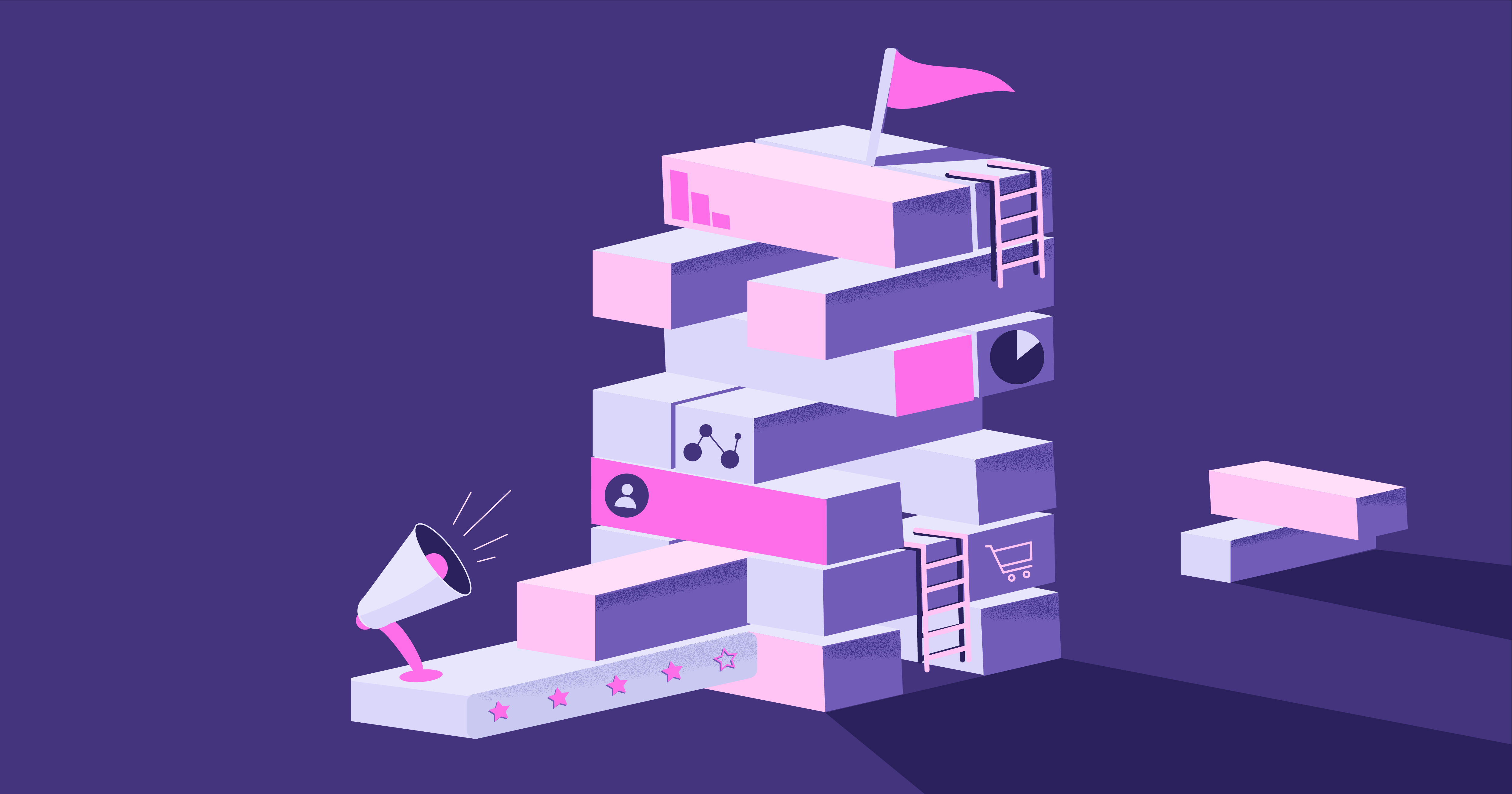Table of Contents
Choosing the wrong tools can be costly, both in terms of wasted resources and missed opportunities. Ineffective tools can lead to disjointed campaigns, lost leads, and a frustrating lack of results. On the other hand, the right tools can supercharge your marketing efforts, streamline your workflow, and propel your business to new heights.
But how do you navigate this complex landscape and find the perfect tools for your unique needs? That’s where this ultimate guide comes in. We’ll not only define what marketing tools are but also categorize them by function, provide illustrative examples, and offer expert guidance on selecting the right ones for your business. Whether you’re a seasoned marketer or a budding entrepreneur, this guide will equip you with the knowledge you need to build a powerful marketing arsenal that drives real results.
What Are Marketing Tools?
In the simplest terms, marketing tools are instruments, platforms, or software that assist businesses in promoting their products or services. They are the backbone of any successful marketing strategy, facilitating tasks that range from crafting compelling content to analyzing campaign performance.
At their core, marketing tools serve to:
- Amplify reach: They help you connect with a wider audience across various channels.
- Enhance engagement: They enable you to create meaningful interactions with potential and existing customers.
- Streamline processes: They automate repetitive tasks, freeing up your time for strategic planning.
- Measure impact: They provide valuable data insights to assess the effectiveness of your marketing campaigns.
Marketing tools can be as simple as a pen and paper for brainstorming ideas or as complex as AI-powered platforms that generate personalized content and predict customer behavior. Based on their function, they can be categorized into various types, such as content creation tools, social media management tools, email marketing platforms, SEO (Search Engine Optimization) software, analytics dashboards, and more.
The evolution of marketing tools has been nothing short of revolutionary. From the early days of print advertising and direct mail to the rise of digital marketing and the recent explosion of AI-powered tools, the options available to marketers today are more diverse and sophisticated than ever before.
This evolution is driven by:
- Technological advancements: The rapid pace of technological innovation has led to the development of new and improved marketing tools.
- Changing consumer behavior: The way people consume information and interact with brands has evolved, requiring marketers to adapt their strategies and tools.
- The need for data-driven decision-making: The ability to collect and analyze data has become paramount for effective marketing, driving the demand for tools that provide valuable insights.
This guide will delve deeper into the different types of marketing tools available, helping you understand their functions and benefits and how to choose the right ones for your business. Whether you’re a seasoned marketer or a newcomer to the field, mastering the art of using marketing tools is essential for success in today’s competitive landscape.
Types of Marketing Tools
A. Website Builders
your website is your virtual storefront, your online business card, and a powerful marketing tool in itself. A well-designed website is essential for establishing your brand identity, showcasing your products or services, and engaging with your audience. Website builders empower you to create and customize your online presence without needing extensive technical knowledge.
Key Features of Website Builders:
- Drag-and-drop interface: Easily arrange elements on your pages without writing code.
- Templates: Choose from pre-designed layouts to kickstart your design.
- Mobile responsiveness: Ensure your site looks great on all devices.
- SEO tools: Optimize your site for search engines to attract organic traffic.
- E-commerce integration: Set up an online store to sell products directly from your website.
Elementor: No Code Website Builder
Elementor stands out as a top-tier website builder, particularly for those using WordPress. Its intuitive drag-and-drop editor, extensive template library, and powerful design features make it a go-to choice for creating stunning, high-performing websites.
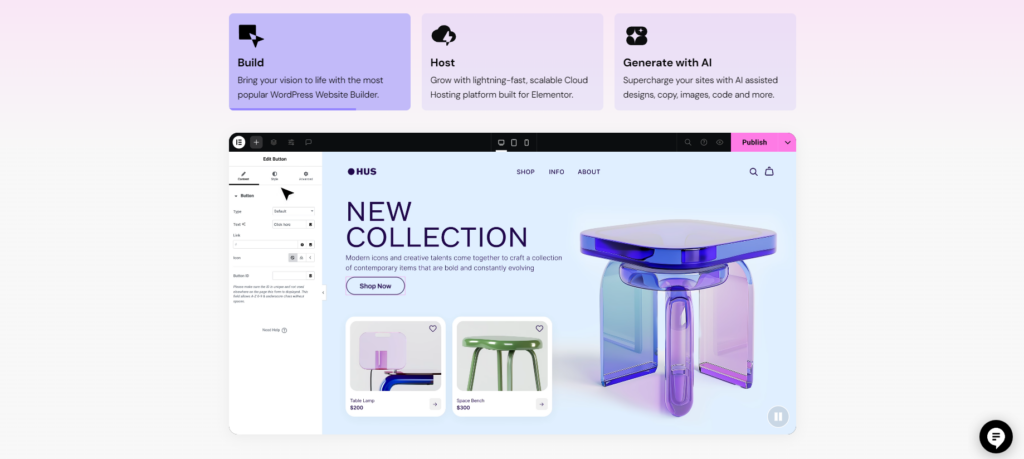
Key Advantages of Elementor:
- Theme Builder: Customize every aspect of your site, from headers and footers to archive pages and single posts.
- WooCommerce Builder: Create a seamless online shopping experience with custom product pages, checkout flows, and more.
- Popup Builder: Design eye-catching popups to capture leads, promote offers, or deliver important messages.
- Global Widgets: Create custom widgets once and reuse them across your site for consistency.
- Extensive Integrations: Connect with popular marketing and CRM tools to streamline your workflow.
Who Should Use Elementor?
Elementor is a versatile tool suitable for a wide range of users:
- Small businesses: Create a professional website without the need for a web developer.
- E-commerce stores: Design a beautiful and functional online store to drive sales.
- Agencies: Build and manage multiple client websites efficiently.
- Designers: Unleash your creativity with advanced design options and custom CSS.
Elementor AI: The Future of Website Building
In addition to the traditional website builder, Elementor offers an AI-powered version that takes website creation to the next level. Elementor AI leverages artificial intelligence to streamline the design process, generate content, and enhance the overall user experience.
Key Features of Elementor AI:
- AI-Powered Design: Generate layouts, suggest elements, and provide design recommendations based on your preferences.
- Text and Image Generation: Create compelling content and visuals with AI-powered tools.
- Code Generation: Generate HTML, CSS, and JavaScript snippets for custom elements and interactions.
Why Choose Elementor AI?
- Save Time and Effort: Automate repetitive tasks and speed up the design process.
- Enhance Creativity: Get inspired by AI-generated suggestions and explore new design possibilities.
- Optimize for Performance: Leverage AI insights to improve your site’s speed and user experience.
Elementor AI is a game-changer for website builders, offering a glimpse into the future of web design. It’s a must-have tool for anyone looking to create a cutting-edge website that stands out from the competition.
B. Content Creation and Management Tools
Content is the cornerstone of any digital marketing strategy. It’s what draws visitors to your website, educates them about your brand, and compels them to take action. Content creation and management tools help you plan, produce, and distribute high-quality content that resonates with your target audience.
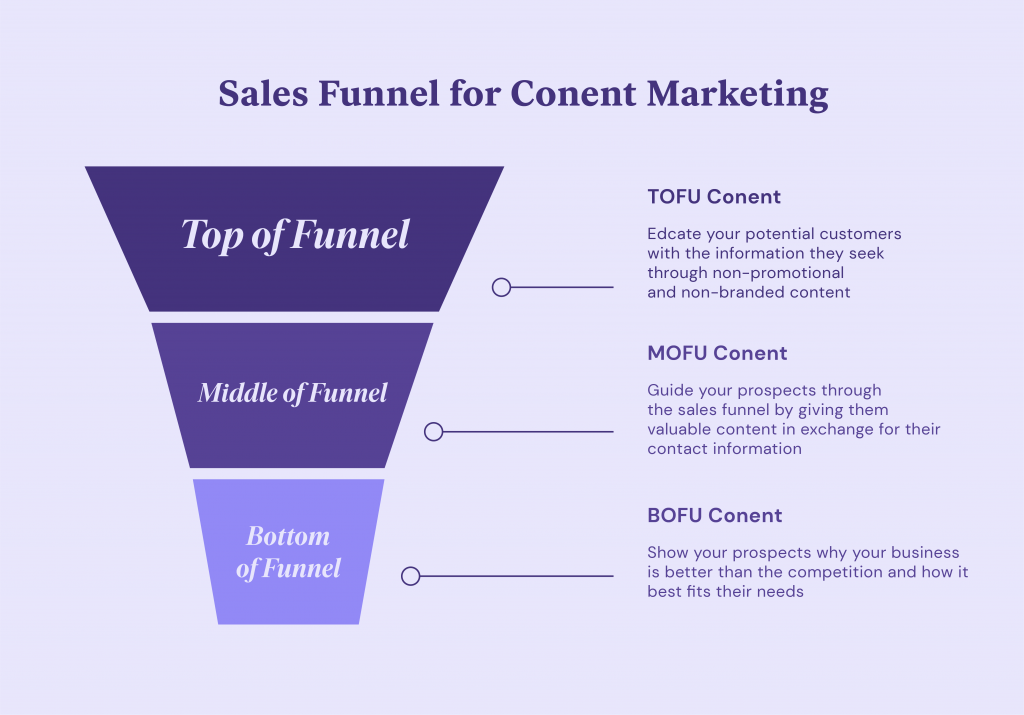
Key Features of Content Creation and Management Tools:
- Content calendars: Plan and schedule your content in advance to maintain consistency.
- Writing and editing tools: Craft compelling blog posts, articles, social media updates, and more.
- Image and video editing software: Create visually appealing visuals to accompany your content.
- Content distribution platforms: Share your content across multiple channels, including social media, email, and your website.
- Content analytics: Track the performance of your content to see what’s working and what needs improvement.
Examples of Content Creation and Management Tools:
- Canva: A user-friendly graphic design tool for creating social media graphics, presentations, posters, and more.
- Grammarly: An AI-powered writing assistant that checks grammar, spelling, and style.

- Buffer: A social media management tool for scheduling posts, analyzing performance, and engaging with your audience.
- Google Analytics: A free web analytics service that tracks and reports website traffic.
Elementor’s Role in Content Creation and Management
While Elementor is primarily known for its website-building capabilities, it also offers several features that can streamline your content creation and management workflow.
- Content Editing: Elementor’s visual editor allows you to create and edit blog posts and pages directly on your website’s front end. This makes it easy to see how your content will look in real-time as you work.
- Content Templates: Choose from a variety of pre-designed templates to quickly create professional-looking content.
- Global Widgets: Create custom content elements, such as calls to action or testimonials, and reuse them across your site.
By integrating Elementor into your content creation process, you can streamline your workflow, ensure consistency across your website, and ultimately create more engaging content that resonates with your audience.
C. Social Media Marketing Tools
Social media is a marketing powerhouse. It’s where your audience spends their time, connects with friends, and discovers new brands. Social media marketing tools help you manage your presence across multiple platforms, engage with your followers, and track your social media performance.

Key Features of Social Media Marketing Tools:
- Scheduling and Publishing: Plan and schedule posts in advance to maintain a consistent presence.
- Content Creation: Design engaging visuals, write compelling captions, and curate relevant content.
- Community Management: Respond to comments, messages, and mentions promptly to foster engagement.
- Analytics and Reporting: Track key metrics like reach, engagement, and conversions to measure the effectiveness of your campaigns.
- Advertising: Create and manage targeted social media ads to reach a wider audience.
Examples of Social Media Marketing Tools:
- Buffer: Schedule posts, analyze performance, and engage with your audience across multiple social media platforms.
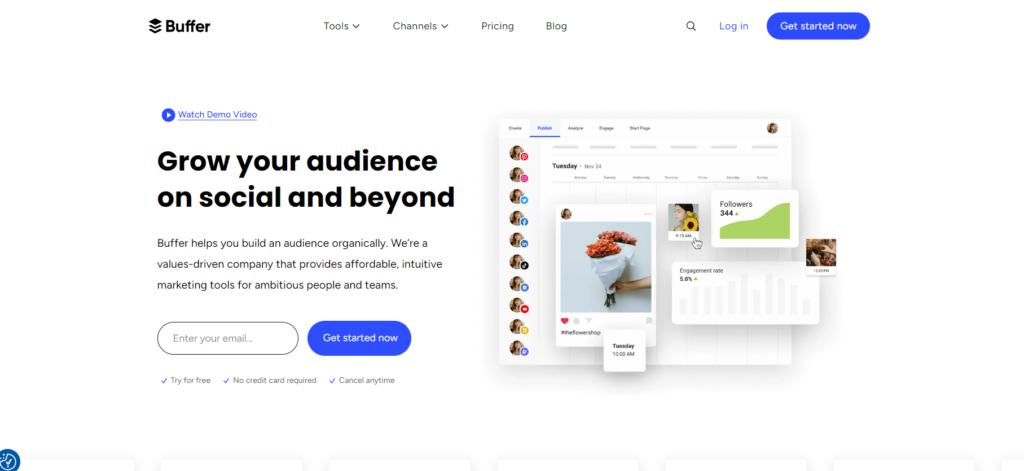
- Hootsuite: Manage multiple social accounts, schedule posts, track mentions, and analyze results from a single dashboard.
- Sprout Social: A comprehensive social media management platform with features for listening, publishing, engagement, and analytics.
- Later: A visual content planner and scheduler designed for Instagram, Pinterest, and other visual platforms.
- Canva: Create eye-catching social media graphics with its user-friendly interface and extensive template library.

Elementor’s Role in Social Media Marketing
While Elementor doesn’t directly offer social media management features, it can play a crucial role in your social media marketing strategy. Here’s how:
- Integrating Social Feeds: Embed social media feeds on your website to showcase your latest posts and encourage engagement.
- Promoting Social Sharing: Add social sharing buttons to your website’s content to encourage visitors to share your posts with their networks.
- Creating Landing Pages for Social Ads: Design high-converting landing pages specifically for your social media advertising campaigns.
By leveraging Elementor’s design capabilities and integrations, you can create a more cohesive and effective social media marketing strategy that drives results.
D. Email Marketing Tools
Email remains a cornerstone of digital marketing, providing a direct line of communication with your audience. Email marketing tools enable you to build email lists, create and send engaging campaigns, automate workflows, and track the success of your efforts.
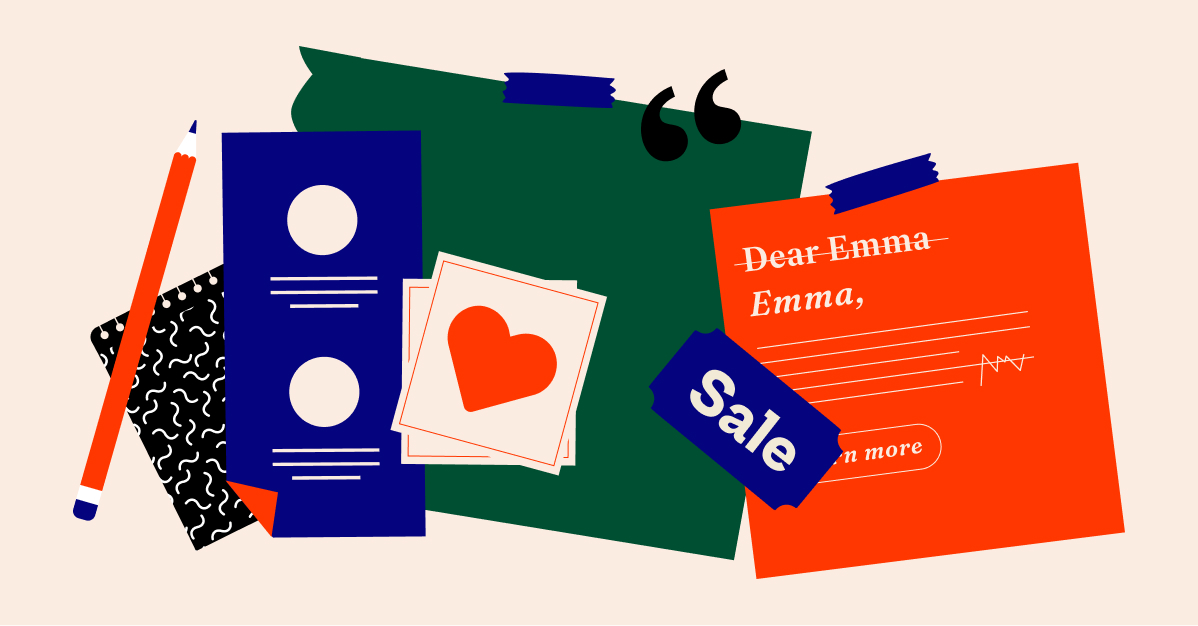
Key Features of Email Marketing Tools:
- List Management: Easily manage your subscriber lists, segment them based on interests or demographics, and maintain clean data.
- Email Design: Create visually appealing emails with drag-and-drop editors, customizable templates, and personalized content.
- Automation: Set up automated email sequences for welcome messages, abandoned cart reminders, post-purchase follow-ups, and more.
- A/B Testing: Experiment with different subject lines, content, and calls to action to optimize your campaigns.
- Analytics: Track open rates, click-through rates, conversions, and other key metrics to measure the effectiveness of your emails.
SEND: A Powerful Email Marketing Platform for Growing Businesses
SEND is a top email marketing platform designed for small—to medium-sized businesses. It offers a robust set of features to boost engagement and sales. Seamlessly integrating with WooCommerce, SEND empowers users to leverage customer data for personalized email and SMS campaigns.

Key Features:
- Automation: Create automated workflows based on customer behavior and triggers for timely, relevant communication.
- Segmentation: Segment contacts for targeted messaging, increasing open rates and conversions.
- Email & SMS Marketing: Reach customers through both email and SMS channels with intuitive editors and customizable templates.
- Form Integration: Easily capture leads and grow email lists by integrating with popular WordPress form builders.
- Comprehensive Analytics: Track campaign performance, measure ROI, and gain actionable insights to optimize marketing strategies.
- User-Friendly Interface: An intuitive interface makes SEND accessible to users of all technical levels.
Overall, SEND is a valuable tool for businesses seeking to enhance their marketing efforts. It provides the capabilities to create, automate, and analyze email and SMS campaigns that drive results.
Elementor’s Role in Email Marketing
While Elementor doesn’t offer a dedicated email marketing tool, it can significantly enhance your email marketing efforts.
- Designing Landing Pages: Create beautiful and engaging landing pages to capture email addresses and grow your list.
- Integrating with Email Marketing Platforms: Elementor seamlessly integrates with popular email marketing tools like Mailchimp, allowing you to embed signup forms and automate email campaigns.
- Creating Visually Consistent Emails: Use Elementor’s design elements and styling options to create emails that match your website’s branding and aesthetics.
By combining Elementor’s design capabilities with the power of email marketing platforms, you can create a cohesive and effective email marketing strategy that drives results.
E. SEO Tools
In the vast landscape of the internet, more is needed just to have a website or create great content. You need to ensure that your target audience can find you. That’s where Search Engine Optimization (SEO) comes in. SEO tools are designed to help you optimize your website and content to rank higher in search engine results pages (SERPs), driving organic traffic and increasing visibility.

Key Features of SEO Tools:
- Keyword Research: Identify relevant keywords and phrases that your target audience is searching for.
- On-Page Optimization: Analyze your website’s structure, content, and meta tags to ensure they are optimized for search engines.
- Technical SEO: Identify and fix technical issues that could be hindering your website’s search results performance.
- Link Building: Track backlinks to your website and identify opportunities to build high-quality links from other reputable sites.
- Competitor Analysis: Monitor your competitors’ SEO strategies and identify areas where you can improve.
Examples of SEO Tools:
- SEMrush: A comprehensive SEO platform with tools for keyword research, competitor analysis, backlink analysis, site audits, and more.
- Ahrefs: A powerful backlink analysis tool that also offers features for keyword research, content exploration, and rank tracking.
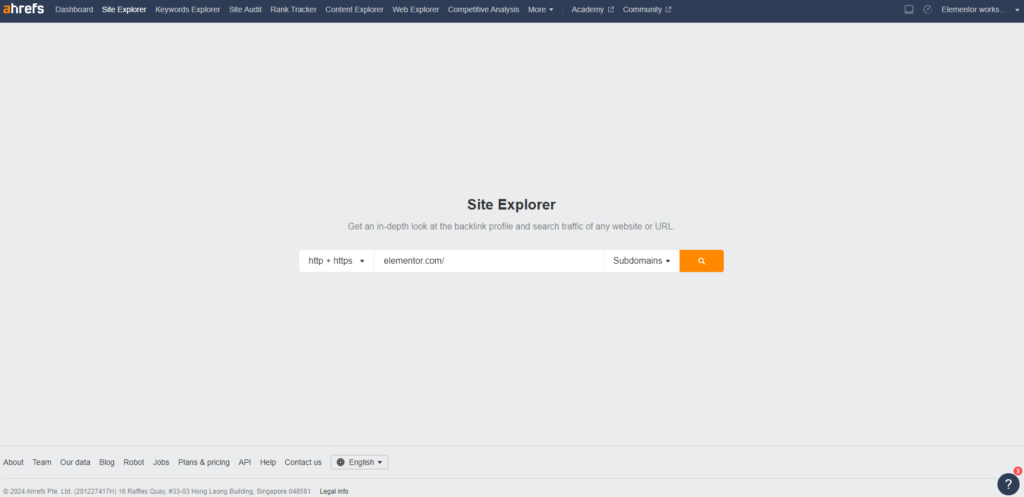
- Moz: A well-respected SEO software suite with tools for keyword research, site audits, link building, and local SEO.
- Google Search Console: A free tool from Google that provides insights into your website’s search performance and helps you identify and fix technical issues.
- Yoast SEO: A popular WordPress plugin that helps you optimize your website’s content and meta tags for search engines.
Elementor’s Role in SEO
Elementor, although primarily a website builder, integrates SEO best practices into its core functionality. It provides features that can significantly enhance your website’s SEO performance:
- Lightweight Code: Elementor generates clean, optimized code that helps your website load faster, a crucial factor in SEO ranking.
- Mobile Responsiveness: Ensures your website adapts seamlessly to different screen sizes, improving user experience and SEO.
- SEO-Friendly Structure: Elementor’s sections and widgets are structured with SEO in mind, making it easy to create well-organized content that search engines can easily crawl and index.
- Customizable Meta Tags: Elementor allows you to customize meta titles and descriptions for each page and post, helping you optimize for specific keywords.
- Image Optimization: Elementor’s built-in image optimizer compresses and optimizes images for faster loading, improving overall website performance and SEO.
Additionally, Elementor seamlessly integrates with popular SEO plugins like Yoast SEO, providing a comprehensive solution for optimizing your website and content for search engines.
F. Paid Advertising Tools
Paid advertising, also known as PPC (Pay-Per-Click), is a powerful way to drive targeted traffic to your website and generate leads or sales. Paid advertising tools help you create, manage, and optimize your ad campaigns across various platforms, such as Google Ads, social media ads, and display advertising networks.

Key Features of Paid Advertising Tools:
- Campaign Creation: Design and launch ad campaigns with customizable targeting options, ad formats, and bidding strategies.
- Ad Management: Monitor and adjust your campaigns in real-time to improve performance.
- Keyword Research: Identify high-performing keywords to target in your search ads.
- Budget Optimization: Allocate your budget effectively to maximize your return on investment (ROI).
- Reporting and Analytics: Track key metrics like impressions, clicks, conversions, and cost per click to measure the success of your campaigns.
Examples of Paid Advertising Tools:
- Google Ads: Google Ads is the most popular advertising platform, allowing you to create search, display, and video ads that appear across Google’s vast network.
- Facebook Ads Manager: Create and manage ads on Facebook, Instagram, and Messenger, targeting specific demographics, interests, and behaviors.
- Microsoft Advertising: Reach a different audience with search and display ads on the Bing network.
- Taboola and Outbrain: Promote your content on popular news and media websites through native advertising.

- AdRoll: A retargeting platform that helps you reach users who have previously visited your website with personalized ads.
Elementor’s Role in Paid Advertising
Elementor can be a valuable asset in your paid advertising strategy, helping you create high-converting landing pages and ad creatives that drive results.
- Landing Page Design: Design visually appealing and persuasive landing pages that are optimized for conversions.
- Ad Creative Design: Create eye-catching banner ads and social media graphics that stand out from the competition.
- A/B Testing: Experiment with different landing pages and ad variations to find the most effective combinations.
- Integration with Google Ads: Seamlessly track conversions from your Google Ads campaigns directly within Elementor.
By using Elementor to create compelling landing pages and ad creatives, you can increase the effectiveness of your paid advertising campaigns and achieve a higher ROI.
G. Marketing Automation Tools
In the fast-paced world of digital marketing, efficiency is key. Marketing automation tools empower you to automate repetitive tasks, streamline workflows, and nurture leads more effectively. These tools use pre-defined triggers and actions to deliver personalized messages and content to your audience at the right time based on their behavior and preferences.
Key Features of Marketing Automation Tools:
- Email Automation: Create automated email sequences for welcome messages, lead nurturing, re-engagement, and more.
- Lead Scoring: Assign scores to leads based on their engagement and behavior to identify the most qualified prospects.
- CRM Integration: Connect with your customer relationship management (CRM) system to track and manage leads throughout the sales funnel.
- Personalized Content: Deliver targeted content and offers based on individual preferences and behaviors.
- Analytics and Reporting: Track the performance of your automated campaigns to identify areas for improvement.
Examples of Marketing Automation Tools:
- HubSpot: A comprehensive marketing, sales, and service platform with powerful automation features for lead nurturing, email marketing, and social media.
- Marketo: An enterprise-level marketing automation platform with advanced features for lead management, campaign creation, and analytics.
- Pardot: A Salesforce-owned marketing automation platform designed for B2B businesses.
- ActiveCampaign: A versatile marketing automation platform that combines email marketing, automation, CRM, and sales features.
Elementor’s Role in Marketing Automation
Elementor can be a valuable addition to your marketing automation toolkit. It helps you create landing pages, popups, and forms that capture leads and trigger automated workflows.
- Lead Capture Forms: Design and embed customizable forms on your website to collect email addresses and other lead information.
- Popup Builder: Create targeted popups that appear at the right moment to capture leads or promote offers.
- Integration with Marketing Automation Platforms: Elementor seamlessly integrates with popular marketing automation tools like SEND, HubSpot, and ActiveCampaign, allowing you to trigger automated emails and workflows based on user actions on your website.
By combining Elementor’s design capabilities with the power of marketing automation platforms, you can create a seamless and effective lead-nurturing process that drives conversions.
H. Marketing Analytics Tools
Data is the lifeblood of modern marketing. It’s what helps you understand your audience, measure the success of your campaigns, and make informed decisions about your marketing strategy. Marketing analytics tools empower you to collect, track, and analyze data from various sources, giving you valuable insights into what’s working and what’s not.
Key Features of Marketing Analytics Tools:
- Data Collection: Gather data from your website, social media, email campaigns, and other marketing channels.
- Data Tracking: Monitor key metrics like website traffic, engagement, conversions, and ROI.
- Data Analysis: Use advanced analytics to identify trends, patterns, and correlations in your data.
- Reporting: Create customizable reports and dashboards to visualize your data and share insights with your team.
- Attribution Modeling: Determine which marketing channels and touchpoints are most effective in driving conversions.
Examples of Marketing Analytics Tools:
- Google Analytics: A free and powerful web analytics tool that tracks website traffic, user behavior, and conversions.

- Adobe Analytics: An enterprise-level analytics platform with advanced features for data collection, analysis, and reporting.
- Mixpanel: A product analytics tool that helps you understand how users interact with your website or app.
- Kissmetrics: A customer analytics platform that focuses on tracking individual user behavior across multiple channels.
- Hotjar: A behavior analytics tool that provides heatmaps, session recordings, and surveys to help you understand how users interact with your website.
I. CRM (Customer Relationship Management) Tools
Strong customer relationships are at the heart of every successful business. CRM tools are designed to help you manage and nurture these relationships throughout the entire customer journey, from initial contact to post-purchase engagement. These tools centralize customer data, automate communication, and provide insights to deliver personalized experiences that build loyalty and drive sales.
Key Features of CRM Tools:
- Contact Management: Store and organize customer data, including contact information, interactions, purchase history, and preferences.
- Lead Management: Track leads, qualify them, and nurture them through the sales funnel with personalized communication and targeted offers.
- Sales Automation: Automate sales tasks like lead assignment, follow-up emails, and pipeline management to improve sales efficiency.
- Customer Service: Manage customer inquiries, resolve issues, and provide support through various channels, such as email, live chat, and social media.
- Marketing Automation: Integrate with your marketing tools to automate email campaigns, personalize content, and track customer engagement.
- Analytics and Reporting: Gain insights into customer behavior, sales performance, and marketing effectiveness to make data-driven decisions.
Examples of CRM Tools:
- Salesforce: A leading CRM platform with a wide range of features for sales, service, marketing, and analytics.
- HubSpot: A popular all-in-one CRM platform with tools for marketing, sales, customer service, and operations.
- Zoho CRM: A cloud-based CRM solution with a user-friendly interface and customizable features for businesses of all sizes.
- Pipedrive: A sales-focused CRM designed to help you visualize and manage your sales pipeline.

- Freshsales: A CRM platform with a focus on lead generation, sales management, and customer engagement.
Elementor’s Role in CRM
While Elementor doesn’t offer a dedicated CRM tool, it can play a significant role in supporting your CRM strategy.
- Lead Capture: Use Elementor’s forms and popups to capture leads and integrate them directly with your CRM system.
- Personalized Content: Create personalized landing pages and website content for different customer segments based on data from your CRM.
- Tracking and Analytics: Integrate Elementor with your CRM to track website visitor behavior and attribute leads and sales to specific marketing campaigns.
By leveraging Elementor’s capabilities in conjunction with your CRM, you can create a more personalized and effective customer journey that fosters loyalty and drives revenue.
J. Project Management and Collaboration Tools
Marketing campaigns often involve multiple team members, complex timelines, and a myriad of tasks. Project management and collaboration tools help you keep everything organized, ensure smooth communication, and meet deadlines efficiently. These tools facilitate task assignments, progress tracking, file sharing, and real-time communication, fostering a productive and collaborative environment.
Key Features of Project Management and Collaboration Tools:
- Task Management: Create and assign tasks, set deadlines, and track progress.
- Communication: Facilitate real-time communication through chat, video calls, and comments.
- File Sharing and Collaboration: Share documents, images, and other files with team members and collaborate on them in real-time.
- Project Planning: Create project timelines, set milestones, and allocate resources effectively.
- Reporting: Generate reports on project progress, team performance, and resource utilization.
Examples of Project Management and Collaboration Tools:
- Monday.com: A customizable work operating system (Work OS) that allows you to build workflows and automate processes.

- Asana: A popular project management tool with features for task management, team collaboration, and project visualization.
- Trello: A visual project management tool that uses boards, lists, and cards to organize and prioritize tasks.
- Basecamp: A project management and team communication platform that combines to-do lists, schedules, file sharing, and messaging.
- Slack: A real-time messaging and collaboration platform for teams.
K. Public Relations (PR) Tools
While often overlooked in the digital age, public relations (PR) remains a vital component of a well-rounded marketing strategy. PR tools help you manage your brand’s reputation, build relationships with media outlets and influencers, and secure media coverage.
Key Features of PR Tools:
- Media Database: Access a comprehensive database of journalists, bloggers, and influencers to pitch your stories.
- Media Monitoring: Track mentions of your brand, products, or services across online and offline media.
- Press Release Distribution: Create and distribute press releases to targeted media outlets.
- Media Outreach: Build relationships with journalists and influencers through personalized outreach.
- Reputation Management: Monitor and manage your brand’s online reputation, addressing negative reviews or comments.
Examples of PR Tools:
- Cision: A leading PR software platform with tools for media monitoring, distribution, analysis, and influencer outreach.
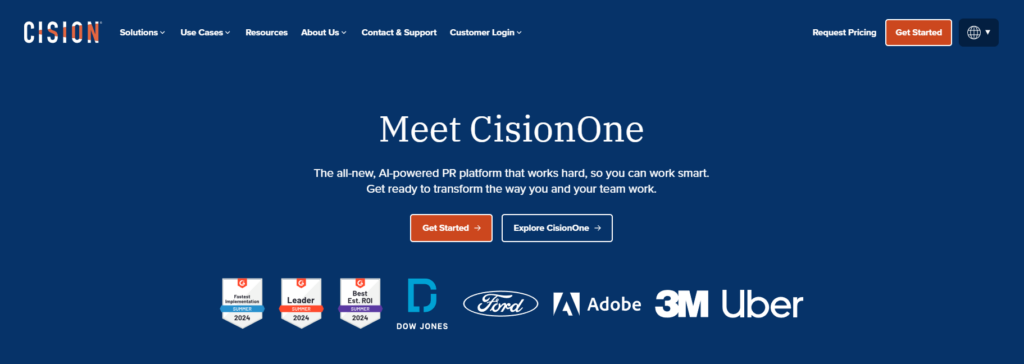
- Muck Rack: A platform that connects journalists with PR professionals and offers tools for media monitoring and outreach.
- Meltwater: A media intelligence platform that provides real-time monitoring, analysis, and reporting of media coverage.
- HARO/Connectively (Help a Reporter Out): A free platform that connects journalists with sources for their stories.
- BuzzSumo: A content discovery and influencer marketing platform that helps you identify trending topics and influential voices in your industry.
Elementor’s Role in Public Relations
While Elementor is not directly a PR tool, it can play a crucial role in supporting your PR efforts.
- Media-Friendly Website: Ensure your website is optimized for media consumption by making it easy to find press releases, contact information, and brand assets.
- Content Creation: Create engaging content like blog posts, articles, and case studies that can be pitched to journalists and bloggers.
By leveraging Elementor’s design capabilities, you can create a professional and informative online presence that attracts media attention and enhances your brand’s reputation.
L. Influencer Marketing Platforms
In the age of social media, influencers wield significant power in shaping consumer opinions and behaviors. Influencer marketing platforms connect brands with relevant influencers to create authentic and engaging content that resonates with their target audience. These platforms streamline the process of finding, vetting, and collaborating with influencers, making it easier to leverage their reach and influence for your marketing campaigns.
Key Features of Influencer Marketing Platforms:
- Influencer Discovery: Search and filter through a vast database of influencers based on niche, audience demographics, engagement rates, and other criteria.
- Campaign Management: Create and manage influencer campaigns, set goals, track progress, and measure results.
- Content Collaboration: Facilitate collaboration between brands and influencers on content creation and distribution.
- Payment and Contract Management: Streamline the process of negotiating contracts and paying influencers.
- Analytics and Reporting: Track the performance of your influencer campaigns and measure their impact on brand awareness, engagement, and sales.
Examples of Influencer Marketing Platforms:
- Upfluence: An all-in-one influencer marketing platform that helps you find, connect with, and manage influencers across various social media channels.
- Grin: An influencer marketing platform that focuses on building authentic relationships between brands and influencers.
- AspireIQ: A platform that streamlines the entire influencer marketing process, from discovery to measurement.
- CreatorIQ: An enterprise-level influencer marketing platform with advanced features for data analysis and reporting.
Elementor’s Role in Influencer Marketing
Elementor can be a valuable asset in your influencer marketing strategy, primarily through its website-building capabilities.
- Creating Influencer Landing Pages: Design dedicated landing pages for influencer campaigns that feature the influencer’s content and promote your brand or products.
- Showcasing Influencer Content: Embed social media posts from influencers on your website to add credibility and social proof.
By incorporating Elementor into your influencer marketing efforts, you can create a more engaging and effective online presence that amplifies the impact of your influencer partnerships.
M. Affiliate Marketing Tools
Affiliate marketing is a performance-based marketing strategy where businesses reward affiliates for each customer or visitor brought by their marketing efforts. It’s a popular way to expand your reach and drive sales through partnerships with other individuals or businesses. Affiliate marketing tools help you manage your affiliate programs, track performance, and reward your affiliates for their contributions.
Key Features of Affiliate Marketing Tools:
- Affiliate Recruitment: Attract and onboard new affiliates to promote your products or services.
- Link Tracking and Management: Generate unique affiliate links, track clicks and conversions, and attribute sales to specific affiliates.
- Commission Management: Calculate and distribute commissions to your affiliates based on their performance.
- Reporting and Analytics: Track key metrics like clicks, conversions, revenue, and ROI to evaluate the effectiveness of your affiliate program.
- Communication and Support: Provide communication channels and resources to support your affiliates and help them succeed.
Examples of Affiliate Marketing Tools:
- ShareASale: A popular affiliate marketing network that connects merchants with a large network of affiliates.
- Commission Junction (CJ): Another major affiliate network with a wide range of advertisers and publishers.
- ClickBank: A global e-commerce platform and affiliate marketplace that specializes in digital products.
- Amazon Associates: Amazon’s affiliate program allows you to earn commissions by promoting products on their website.
- Refersion: An affiliate marketing platform that offers customizable tracking, reporting, and automation features.
Elementor’s Role in Affiliate Marketing
Elementor can be a valuable tool for affiliate marketers. It helps them create high-converting landing pages and promotional materials to attract and engage potential customers.
- Landing Page Design: Design visually appealing and persuasive landing pages that highlight the benefits of the products or services you’re promoting as an affiliate.
- Call-to-Action Optimization: Create compelling calls to action (CTAs) that encourage visitors to click on your affiliate links and make purchases.
- Split Testing: Experiment with different landing pages and CTA variations to optimize for conversions.
By leveraging Elementor’s design capabilities and integrations, you can create effective marketing materials that drive more clicks, conversions, and commissions from your affiliate marketing efforts.
N. Offline Marketing Tools
While digital marketing has taken center stage in recent years, offline marketing tools still play a crucial role in reaching audiences and promoting brands. Offline marketing encompasses traditional methods that don’t rely on the Internet, such as print advertising, direct mail, events, and public relations. These tools can be particularly effective for local businesses, reaching specific demographics and building brand awareness in the physical world.
Key Features of Offline Marketing Tools:
- Print Advertising: Design and distribute brochures, flyers, posters, and other printed materials to promote your products or services.
- Direct Mail: Send personalized letters, postcards, or catalogs to targeted audiences.
- Event Marketing: involves Organizing and promoting events such as trade shows, conferences, workshops, or product launches to engage with potential customers.
- Public Relations: Build relationships with media outlets and secure press coverage through press releases, media pitches, and other PR activities.
- Outdoor Advertising: To reach a wide audience, use billboards, bus ads, transit ads, and other forms of outdoor advertising.
Examples of Offline Marketing Tools:
- Printing Companies: Partner with printing companies to produce high-quality printed marketing materials.
- Mailing Services: Utilize mailing services to handle the printing, addressing, and distribution of direct mail campaigns.
- Event Planning Software: Streamline event planning and execution with software that manages logistics, registration, and promotion.
- PR Agencies: Partner with PR agencies to develop and execute effective PR campaigns that generate media coverage and build brand awareness.
- Outdoor Advertising Companies: Collaborate with outdoor advertising companies to design and place impactful ads in strategic locations.
How to Choose the Right Marketing Tools
With an overwhelming number of marketing tools available, selecting the right ones for your business can feel like navigating a maze. However, with a strategic approach and a clear understanding of your needs, you can build a powerful marketing arsenal that propels your business forward.
A. Factors to Consider When Choosing Marketing Tools
- Business Goals: Your marketing tools should align with your overall business objectives. Are you looking to increase brand awareness, generate leads, drive sales, or improve customer retention? Clearly defining your goals will help you identify the types of tools you need.
- Target Audience: Understanding your target audience is crucial in choosing the right tools. Where do your ideal customers spend their time online? What kind of content do they engage with? Tailor your tool selection to the platforms and channels where your audience is most active.
- Budget: Marketing tools come with varying costs. Set a realistic budget for your marketing technology stack and explore both free and paid options. Remember, the most expensive tool is only sometimes the best fit for your needs.
- Ease of Use: User-friendliness is a critical factor, especially if you have a small team or limited technical expertise. Opt for tools with intuitive interfaces and comprehensive support resources.
- Integrations: Your marketing tools should work together seamlessly. Look for tools that integrate with your existing systems, such as your website builder, CRM, and email marketing platform. This will save you time and streamline your workflow.
- Scalability: When choosing marketing tools, consider your business’s growth potential. Will the tools you select be able to scale with your business as it expands? Choose tools that can accommodate your future needs to avoid having to switch tools later on.
- Features: Evaluate the features offered by different tools and compare them to your specific requirements. Prioritize features that will directly impact your marketing goals.
- Customer Support: Reliable customer support is crucial when encountering issues or needing assistance. Choose tools that offer timely and helpful support through various channels, such as live chat, email, or phone.
O. Video Marketing Tools
Video has emerged as a dominant force in the digital marketing landscape. It’s a versatile medium that can capture attention, convey complex information, and evoke emotions in a way that text and images alone cannot. Video marketing tools empower you to create, edit, and distribute high-quality videos that engage your audience and drive results.
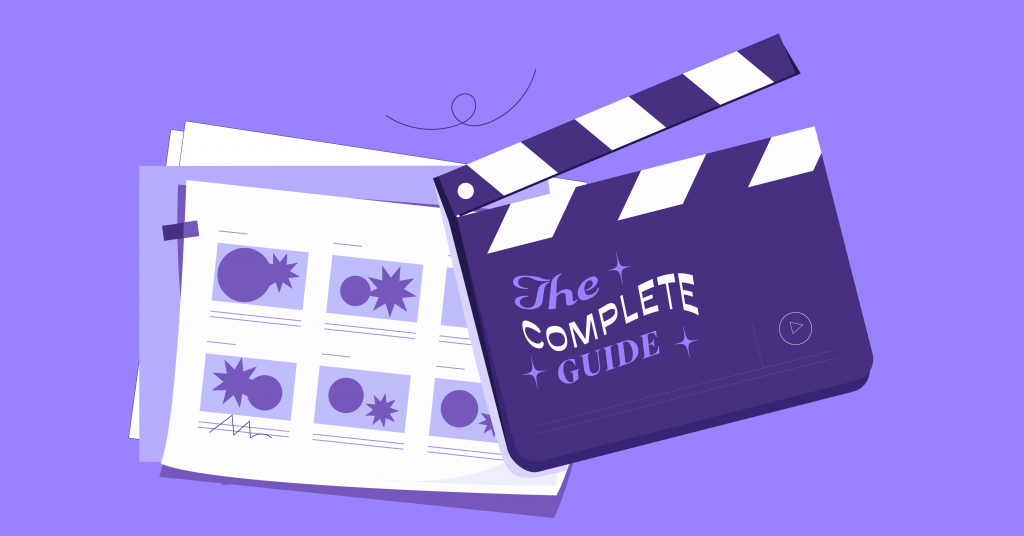
Key Features of Video Marketing Tools:
- Video Editing: Edit and enhance your video footage with features like trimming, cropping, adding transitions, text overlays, and music.
- Screen Recording: Capture your screen to create tutorials, product demos, or explainer videos.
- Video Hosting and Distribution: Host your videos on dedicated platforms and distribute them across various channels, including social media, websites, and email.
- Video Analytics: Track key metrics like views watch time, engagement, and conversions to measure the effectiveness of your videos.
- Interactive Video: To increase engagement, create interactive videos with features like quizzes, polls, and clickable calls to action.
Examples of Video Marketing Tools:
- Adobe Premiere Pro: A professional-grade video editing software with a wide range of features for advanced video production.
- Final Cut Pro: A popular video editing software for Mac users, known for its intuitive interface and powerful editing capabilities.
- Camtasia: A screen recording and video editing tool that makes it easy to create tutorials and presentations.
- Vimeo: A video hosting and sharing platform with features for video collaboration, analytics, and monetization.
- Wistia: A video hosting platform designed for businesses with features for lead generation, marketing automation, and video analytics.
Elementor’s Role in Video Marketing
Elementor can be a valuable asset in your video marketing strategy. It helps you seamlessly integrate videos into your website and landing pages.
- Video Embeds: Easily embed videos from YouTube, Vimeo, or other platforms directly into your Elementor designs.
- Video Backgrounds: Use videos as captivating backgrounds for sections or pages on your website.
- Popup Videos: Create popups that showcase your videos to capture attention and deliver your message effectively.
- Video Galleries: Showcase multiple videos in a visually appealing gallery format.
- Call-to-Action Overlays: Add clickable CTAs to your videos to encourage viewers to take action, such as visiting a landing page or making a purchase.
By incorporating Elementor into your video marketing workflow, you can create a more engaging and immersive online experience that drives results.
P. Community Management and Social Listening Tools
In today’s interconnected world, your online reputation is paramount. Community management and social listening tools help you monitor and engage in conversations about your brand across various online platforms. These tools allow you to track brand mentions, respond to customer feedback, identify potential crises, and gain valuable insights into your audience’s sentiments.

Key Features of Community Management and Social Listening Tools:
- Social Media Monitoring: Track mentions of your brand, products, or industry keywords across various social media platforms.
- Sentiment Analysis: Analyze the sentiment of online conversations to gauge public opinion about your brand.
- Engagement: Respond to comments, questions, and reviews in a timely and professional manner.
- Crisis Management: Identify and address potential PR crises before they escalate.
- Competitive Analysis: Monitor your competitors’ social media presence and engagement.
- Influencer Identification: Discover and connect with influential voices in your industry.
- Reporting: Generate reports on social media engagement, sentiment, and other key metrics.
Examples of Community Management and Social Listening Tools:
- Sprout Social: A comprehensive social media management platform with powerful social listening capabilities.
- Hootsuite: Offers social listening features alongside social media management and scheduling tools.
- Brandwatch: A leading social listening platform with advanced features for data analysis and visualization.
- Mention: A social media monitoring tool that tracks mentions of your brand across various platforms.
- Buffer: Includes social listening features to help you track conversations and engage with your audience.
How to Choose the Right Marketing Tools
B. Tips for Selecting Marketing Tools
With so many options vying for your attention, choosing the right marketing tools can feel overwhelming. However, a few key strategies can help you navigate the process and make informed decisions that align with your business goals and budget.
- Start with the Essentials: Before diving into specialized tools, focus on building a foundation with the essentials:
- Website Builder: A reliable website builder like Elementor is the cornerstone of your online presence. It allows you to create a professional website without coding knowledge, ensuring your brand makes a strong first impression.
- Email Marketing Platform: Email remains a powerful communication channel. Invest in a platform that enables you to build your list, send engaging campaigns, and track performance.
- Analytics Tool: Understanding your website traffic and user behavior is essential for making data-driven decisions. Start with a free tool like Google Analytics to gain valuable insights.
- Research and Compare: Use more than just the first tool you find. Take the time to research different options, compare features and pricing, and read reviews from other users. Many tools offer free trials, allowing you to test them out before committing.
- Consider Your Specific Needs: Not all marketing tools are created equal. Some cater to specific industries or business sizes. Identify your unique requirements and choose tools that address your specific challenges and goals.
- Ask for Recommendations: Contact other marketers or business owners in your industry and ask for their recommendations. They may have valuable insights into tools that have worked well for them.
- Don’t Be Afraid to Experiment: The marketing landscape is constantly evolving, and new tools are emerging constantly. Feel free to try out new tools and see if they can add value to your marketing efforts.
- Prioritize User-Friendliness: If you need to be more tech-savvy, choose tools that are easy to learn and use. A steep learning curve can hinder your productivity and lead to frustration.
- Look for Integrations: Your marketing tools should work together seamlessly. Choose tools that integrate with your existing systems to avoid manual data entry and streamline your workflow.
- Think Long-Term: When selecting tools, consider your business’s future growth. Opt for scalable solutions that can accommodate your evolving needs as your business expands.
By following these tips, you’ll be well on your way to building a powerful marketing tech stack that drives results and helps your business thrive.
Building a Marketing Tech Stack
Creating an effective marketing strategy isn’t just about choosing the right tools; it’s about assembling a cohesive marketing tech stack that works together seamlessly. A marketing tech stack is a collection of software and technologies that empower your marketing team to achieve their goals efficiently.
Think of it as a toolbox where each tool complements the others, creating a harmonious ecosystem that amplifies your efforts and maximizes your impact.
A. The Importance of a Cohesive Marketing Tech Stack
A well-structured marketing tech stack offers numerous benefits, including:
- Streamlined Workflows: Integrate your tools to automate tasks, eliminate manual data entry, and save time.
- Improved Collaboration: Facilitate communication and collaboration among team members by centralizing information and resources.
- Data-Driven Decision Making: Consolidating data from different tools enables you to gain a holistic view of your marketing performance and make informed decisions.
- Enhanced Customer Experience: Deliver personalized experiences across multiple touchpoints by leveraging data and automation.
- Increased ROI: Optimize your marketing spend by identifying the most effective channels and strategies.
With a cohesive marketing tech stack, you can avoid fragmented data, disjointed campaigns, and missed opportunities.
B. Step-by-Step Guide to Building a Marketing Tech Stack
Now that we’ve discussed the importance of a cohesive marketing tech stack let’s explore a step-by-step approach to building one that aligns with your business goals and resources.
- Identify Your Marketing Goals and Strategies:
Before diving into the world of marketing tools, it’s crucial to define your marketing goals and strategies clearly. What are you trying to achieve? Do you want to increase website traffic, generate more leads, improve brand awareness, or boost sales? Once you have a clear understanding of your objectives, you can begin to identify the types of tools that will help you reach them.
- Assess Your Current Marketing Efforts:
Take stock of your existing marketing tools and processes. What’s working well? What’s not? Identify any gaps or inefficiencies that could be addressed with new tools or integrations. This will help you prioritize your investments and ensure that you’re not duplicating efforts.
- Define Your Budget:
Marketing tools come with a range of price tags, from free options to enterprise-level platforms. Based on your available resources and expected return on investment, set a realistic budget for your marketing tech stack. Remember, it’s only sometimes necessary to invest in the most expensive tools to achieve your goals.
- Research and Shortlist Tools:
With your goals, needs, and budget in mind, start researching potential tools that fit your criteria. Explore different categories of marketing tools, compare features and pricing, and read reviews from other users. Make a shortlist of the tools that seem most promising.
- Select and Implement Your Tools:
With a shortlist of potential tools in hand, it’s time to make some decisions. Carefully evaluate each tool based on your specific needs and budget. Consider starting with a few essential tools and gradually adding more specialized tools as your marketing efforts evolve.
Once you’ve selected your tools, implement them one by one, ensuring proper configuration and integration with your existing systems. Take the time to train your team on how to use the tools effectively. Remember, the most powerful tools are only as good as the people using them.
- Monitor, Measure, and Optimize:
Building a marketing tech stack is an ongoing process. It’s important to monitor your tools’ performance regularly, measure their impact on your marketing goals, and optimize your stack as needed. Be bold and replace tools that aren’t delivering results or experiment with new solutions.
Conclusion
In this comprehensive guide, we’ve explored the vast and diverse world of marketing tools. We’ve defined what marketing tools are, delved into various categories with examples, and discussed how to choose the right ones for your business. We’ve also highlighted the crucial role of building a cohesive marketing tech stack and how Elementor can be a valuable asset in this process. By understanding the different types of tools available and their functions, you can make informed decisions about which ones to invest in and how to integrate them into your overall marketing strategy.
Remember, marketing tools are not a magic bullet but rather a means to an end. The key to success lies in understanding your business goals, knowing your target audience, and choosing the right tools that empower you to reach and engage them effectively. By leveraging the power of marketing tools, you can streamline your workflows, enhance your creativity, and drive measurable results for your business.
Looking for fresh content?
By entering your email, you agree to receive Elementor emails, including marketing emails,
and agree to our Terms & Conditions and Privacy Policy.
